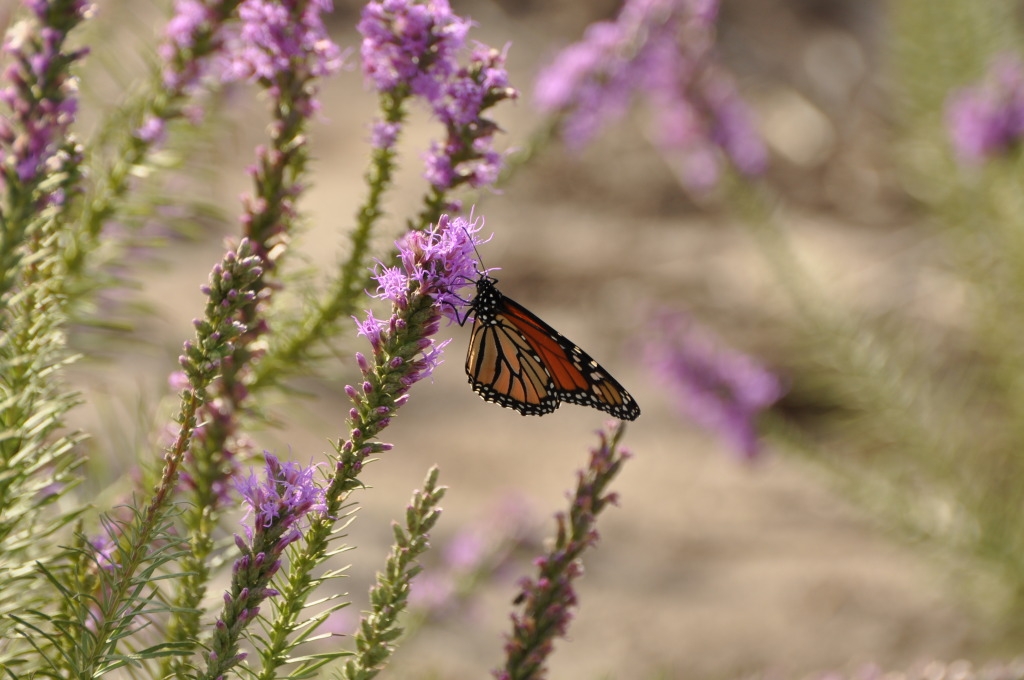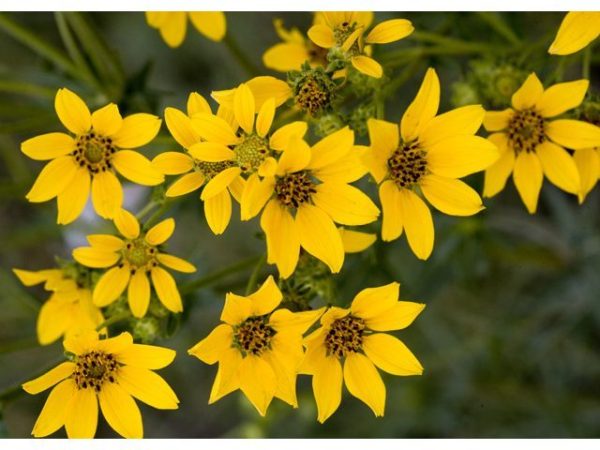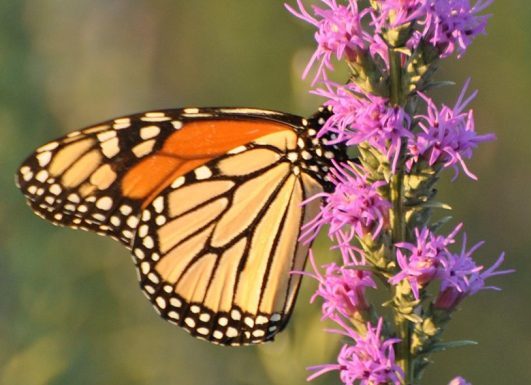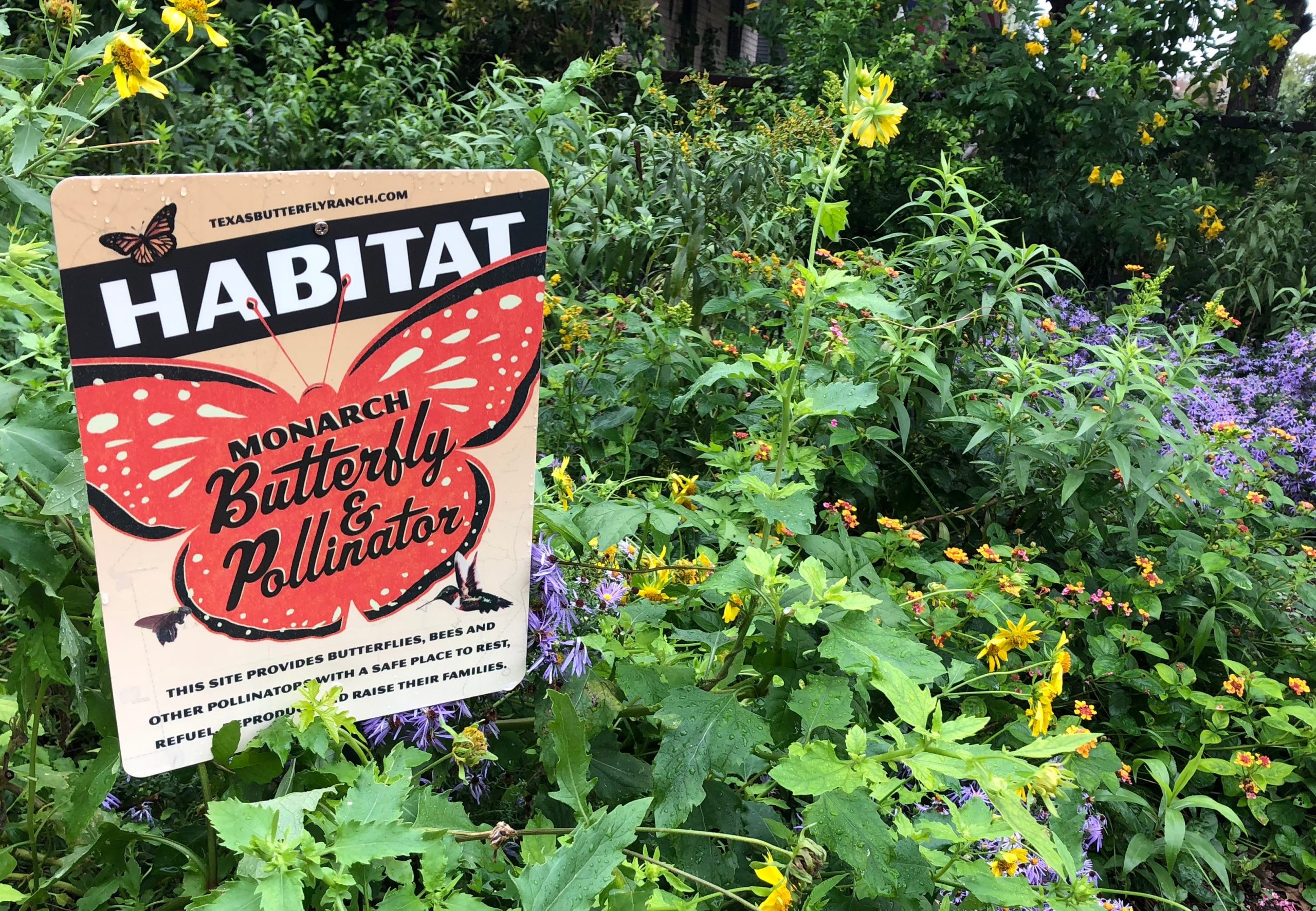The votes are in for the 2022 Unofficial Pollinator Plant of the Year and the winner is…Gayfeather, commonly known as Liatris or Blazing Star.
This year marked the second attempt by this distinctive purple blooming wildflower to claim the title and so it did with more than double the votes of its challenger Engelmann’s daisy. The final tally of 192 votes showed Gayfeather 131, Engelmann’s daisy, 61.
The poll launched in mid January and closed February 16.

Monarch butterfly on Gayfeather at American Native Seed in Junction, TX –photo courtesy American Native Seed
“I’m a little disappointed but not surprised that Liatris won because we have so many yellow wildflowers here that it’s hard for one of them to compete against such spectacular purple blooms,” said Lee Marlowe, president of San Antonio’s Native Plant Society, which partners with the Texas Butterfly Ranch on executing the poll. “Liatris is just so gorgeous!” she added.
Marlowe expressed the hope that native Liatris plants become more available at local and regional nurseries “so we can get more of these beauties in the ground and available for monarchs during their fall migration.”
Despite losing the poll, Engelmann’s daisy may dominate in the field, according to local seed suppliers.
Surging demand and challenging local conditions have made Gayfeather in particular difficult to secure.
“It’s a good plant but there’s no seed this year,” said Forest Smith, who oversees seed sales at DK Seed Company in San Antonio. “It seems to have fallen off the market, and what seed is available is a long way from here and extremely expensive.” Engelmann’s daisy, on the other hand, is widely available, and deer love it.
Smith said Gayfeather is a great plant, especially from a monarch butterfly standpoint, since it blooms in sync with the fall migration. But it’s more challenging to grow, and various species of Liatris exhibit specific soil needs and conditions.

Engelmann’s Daisy (Engelmannia peristenia) Llano County, Texas. Courtesy photo
“A Gayfeather species that will grow on the Hill Country’s rocky slopes is completely different from a species that will grow in sand soil or blackland. In a garden that may not matter that much,” he said.
Engelmann’s daisy, on the other hand, can be planted everywhere. It’s versatile and more more broadly adapted to clay, rocks and sand, and is included in many wildflower mixes used by the Texas Department of Transportation. Thus, it’s more widely available.
At Native American Native Seed in Junction, Texas, restoration specialist George Cates who oversees seed stock, agreed that increased demand has created a short supply of native seeds.
“It’s no longer a fringe thing for people to want native plants. It’s crossed the precipice into the mainstream,” he said.
Despite increased demand, Native American Seed will have plenty of Gayfeather packets for those interested in sowing them, but customers should be aware that it takes three years for the wildflower to reach maturity.
“It’s not as complicated as milkweed,” said Cates. “You’ll get one or two spikes the first year, more the next year. When people see it blooming, they freak out.”
Engelmann’s daisy will be more available available than Gayfeather, and can even be purchased by the pound. In the past, Native American Seed previously offered live roots of Gayfeather but “not that many people wanted to buy them,” said Cates.
Perhaps the wildflower’s win as Unofficial Pollinator Plant of the Year can help change that? “It’s possible,” he said.
Meanwhile, calls to three San Antonio nurseries indicated that neither Gayfeather or Englemann’s live roots, plugs or plants were currently in stock, but San Antonio’s Rainbow Gardens reported they are expecting to have both plants available in limited quantities in March.
Read more about Gayfeather, Liatris punctata var. mucronata.
Read more about Engelmann’s daisy, Engelmann peristenia.
The Unofficial Pollinator Plant of the Year initiative, started in 2019 by the Texas Butterfly Ranch, came about to raise awareness of the unsung plant heroes of the pollinator garden. Many worthy, native plants are commercially unavailable, often only accessible during seasonal pop-up plant sales.
Commercial and retail nurseries cite “lack of demand” as the reason for these plants’ absence in their stores. Our citizen gardener effort aims to create demand that will result in more native plants at gardening centers, local nurseries and big box stores.
When shopping for plants for your pollinator garden, look for Gayfeather or Englemann’s daisy. If you don’t find them, help raise awareness by asking local plant suppliers to stock these worthy natives. If you request these plants each time you visit your favorite local nursery, big box store, or gardening center, buyers and suppliers will get the message that demand exists.
Our successful Pollinator Habitat Initiative has demonstrated that when gardeners take action, we can make a difference.
In 2018, we set out to create 300 pollinator gardens for San Antonio’s 300th birthday. By December 31, 2018, we had pledges for 325 gardens, exceeding our goal by almost 10 percent. In 2019, we pushed for 500 gardens by 2020 and hit the mark by year’s end with 510 gardens pledge. To date, 752 pollinator habitats have been pledged.
Want to join us? Check out the map and pledge to plant a pollinator garden by registering here.
Gayfeather joins Frostweed, Gregg’s mistflower and Cowpen Daisy as our fourth Unofficial Pollinator Plant of the Year. For more info and growing tips, check out our Resources page.
TOP PHOTO: Monarch butterfly nectars on Gayfeather, also known as Liatris. Photo courtesy Native American Seed.
Related posts:
- 2022 Unofficial Pollinator Plant of the Year: Engelmann’s Daisy or Gayfeather? Please vote!
- Cowpen daisy: Unofficial pollinator plant of the year 2019
- 2020 Unofficial pollinator plant of the year: Gregg’s mistflower
- How to plan a successful butterfly garden
- Mostly native butterfly garden outperforms lawn every time
- A year in the life of an urban butterfly garden
- Downtown River walk plot converts to pollinator garden, creature haven
- Converting your Lawn to a Butterfly Garden
- San Antonio becomes first National Wildlife Federation Monarch Champion city
- Tropical Milkweed: To Plant it or Not is Not a Simple Question
Like what you’re reading? Don’t miss a single post from the Texas Butterfly Ranch. Sign up for email delivery, like us on Facebook, or follow us on Twitter, @monikam.



Hello Monika, for me, the Meadow Blazing Star Liatris ligulistylis is definitely the ultimate Monarch butterfly magnet! If you have a plant with 7 stems, when in full bloom, each stem may have 15 butterflies on it. Serious, it’s crazy how powerful this plant is! Plant a patch of L. ligulistylis and you will be rewarded with a sea of fluttering orange flying flowers (Monarch butterflies). Zone 3-7
[…] more about the native Gayfeather (Liatris punctata var. mucronata), you can read up on it both at The Texas Butterfly Ranch and Wildflower.Org. Just know that we do not currently have that specimen here at Rainbow […]